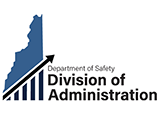About Us
Learn more about the Department of Safety's history.
The Department of Safety is one of the largest state agencies in New Hampshire, with more than 2,200 full-time, part-time, non-classified, and seasonal employees functioning in both uniformed and civilian capacities throughout the state.
The Department regularly partners with local, state, and federal agencies to protect the lives of all New Hampshire residents and visitors. We are tasked with enforcing criminal, motor vehicle and boating laws, and providing for fire safety, fire and emergency medical training, emergency communications and disaster planning.
Established by the New Hampshire General Court in 1961, the Department consists of 7 divisions: Administration, Motor Vehicles, State Police, Homeland Security and Emergency Management, Emergency Services and Communications, Fire Standards and Training & Emergency Medical Services, and Fire Safety.
1961
The Department of Safety is established by the New Hampshire Legislature, originally consisting of three divisions: Motor Vehicles, State Police, and Safety Services.
1987
Under the leadership of Commissioner Richard M. Flynn, the Department is restructured and two additional Divisions and two Bureaus are added: The Division of Enforcement and the Division of Administration; the Bureau of Hearings and the Bureau of Fire Safety.
1989
On January 1, the Bureau of Common Carriers is transferred from the Department of Transportation to the Department of Safety. On July 1, a sixth Division is added: the Division of Fire Service, consisting of the Bureau of Fire Safety, the Bureau of Fire Standards and Training, and the Fire Standards and Training Commission.
1994
Five years after being formed, the Division of Fire Service is restructured into two Divisions, effective August 1: the Division of Fire Standards and Training and the Division of Fire Safety.
1996
On October 1, the Division of Enforcement is eliminated and all former Division personnel and functions are merged into a Bureau of Enforcement, in the Division of State Police.
1999
The Bureau of Emergency Medical Services is transferred from the Department of Health and Human Services, Office of Community and Public Health, to the Department of Safety on November 19.
2002
On July 1, the Emergency Management Agency is transferred from the Office of the Governor to the Department of Safety, Division of Fire Safety and Emergency Management.
The State Fire Marshal becomes the interim Coordinator of Emergency Management.
The Division of Fire Safety becomes the Division of Fire Safety and Emergency Management with two Bureaus, Fire Safety and Emergency Management.
The Division of Emergency Medical Services is merged into the Division of Fire Standards and Training, which becomes the Division of Fire Standards and Training and Emergency Medical Services.
2003
On September 4, the Bureau of Emergency Communications is transferred from the Department of Administrative Services to the Department of Safety, Division of Fire Safety and Emergency Management under the supervision of the Assistant Commissioner of Safety.
The State Fire Marshal becomes the Bureau Chief for the Bureau of Fire Safety, and Bureau Chief and Assistant Chief positions are established for the Bureau of Emergency Management and Emergency Communications, which merges the former Bureau of Emergency Communications and the Emergency Management operation.
The Legislature eliminates the Division of Information Technology in the Department of Safety when it creates a statewide Office of Information Technology, headed by a Chief Information Officer, and along with other major State agencies, our information technology personnel become an embedded operation housed at our facilities and reporting to the Chief Information Officer for the State.
2004
At the start of the year, the Department of Corrections Drug Testing Laboratory and the Department of Health and Human Services, Division of Public Health's laboratory for the testing of blood, breath, and urine to determine alcohol and controlled drug content; and the office of the State Toxicologist, are transferred to the Department of Safety, Division of State Police, Forensic Laboratory.
2006
Effective July 1, the Legislature creates a new position of Director of Homeland Security and Emergency Management and transfers the Bureau of Emergency Management to the Office of the Commissioner, under the supervision of the Director of Homeland Security and Emergency Management.
The Bureau of Emergency Communications remains with the Division of Emergency Services, Communications, and Management.
2019
On April 17, the Executive Council unanimously confirms Robert L. Quinn as Commissioner of the Department of Safety.
Related Resources
Our Mission:
To continually enhance the safety, security and quality of life in New Hampshire through professional, collaborative and innovative service to all.
Our Vision:
To make New Hampshire the safest state in the Nation with the highest quality of life for all.










